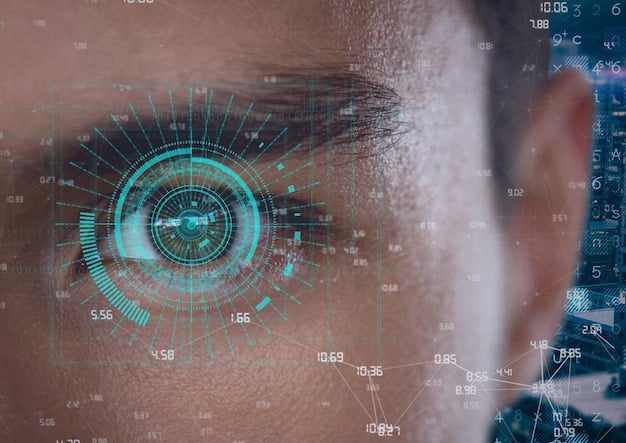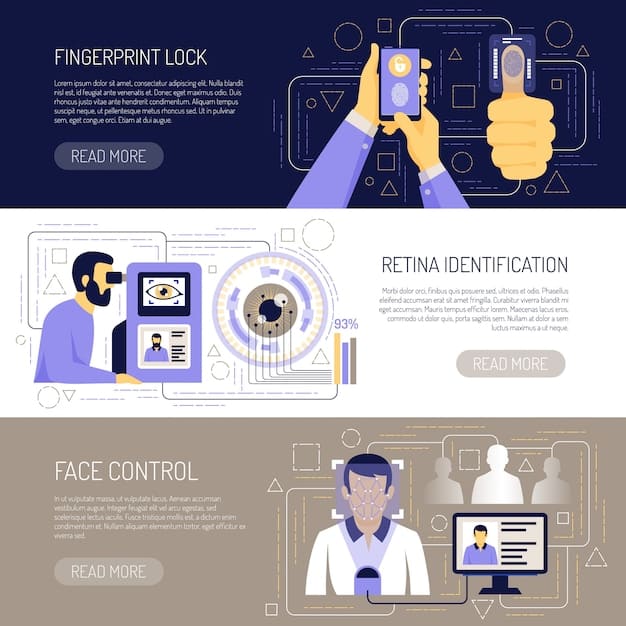Biometric Authentication: How US Fintechs Can Enhance Security

US Fintech companies can leverage biometric authentication such as fingerprint scanning, facial recognition, and voice recognition to enhance security by verifying users’ identities, preventing fraud, and securing transactions. This strengthens trust and protects sensitive financial data.
In today’s digital age, security is paramount, especially in the fintech sector.
How can US fintech companies leverage biometric authentication for enhanced security? This question is increasingly relevant as these companies seek innovative ways to protect sensitive data and prevent fraud. Let’s delve into the world of biometric authentication and explore its potential within the US fintech landscape.
Understanding Biometric Authentication for Fintech
Biometric authentication is a security process that relies on unique biological traits to verify a person’s identity. For fintech companies, this technology offers a robust alternative to traditional passwords and PINs, providing a more secure and user-friendly experience. Let’s explore how various biometric methods can be implemented in the fintech sector.
Types of Biometric Authentication
Several biometric methods are available, each with its strengths and applications. Here are some of the most common types:
- Fingerprint Scanning: One of the most widely used biometric methods, fingerprint scanning is reliable and cost-effective. It involves capturing and analyzing the unique patterns on a person’s fingertips.
- Facial Recognition: This technology identifies individuals by mapping and analyzing facial features from a photograph or video. It is convenient and can be implemented on smartphones and computers.
- Voice Recognition: Voice recognition analyzes unique vocal characteristics to identify and authenticate users. It is user-friendly and can be used for hands-free authentication.
- Iris and Retinal Scanning: These methods scan the unique patterns in the iris or retina of the eye, providing a highly secure authentication process. They are more accurate but also more expensive than other biometric methods.
- Behavioral Biometrics: This includes analyzing patterns in how a user types, moves a mouse, or interacts with a device. It offers continuous authentication and can detect anomalies that may indicate fraudulent activity.
Utilizing these biometric methods allows fintech companies to create multifaceted security systems, adapting to different user needs and threat landscapes. Implementing biometric authentication can significantly reduce the risk of unauthorized access and fraud, enhancing overall security and trust.

Benefits of Biometric Authentication for US Fintechs
The integration of biometric authentication offers numerous advantages for US fintech companies, enhancing security, improving user experience, and streamlining operations. Let’s explore the specific benefits that make biometric authentication a valuable asset in the fintech industry.
Enhanced Security Measures
Biometric authentication provides a higher level of security compared to traditional methods like passwords and PINs. Here’s how:
- Reduced Fraud: Biometric data is difficult to replicate or steal, making it harder for fraudsters to gain unauthorized access to accounts.
- Stronger Authentication: Biometric methods verify a user’s identity based on unique biological traits, providing a more reliable authentication process.
- Protection Against Phishing: Unlike passwords, biometric data cannot be phished, protecting users from social engineering attacks.
- Compliance with Regulations: Using biometric authentication can help US fintech companies comply with stringent data protection regulations, avoiding penalties and maintaining a strong reputation.
Improved User Experience
Biometric authentication can also enhance the user experience, making it easier and faster for customers to access their accounts and conduct transactions:
- Convenience: Biometric authentication eliminates the need for users to remember and enter complex passwords, simplifying the login process.
- Speed: Biometric verification is quick and efficient, allowing users to access their accounts and services in seconds.
- Accessibility: Biometric methods like voice and facial recognition can improve accessibility for users with disabilities, ensuring that fintech services are inclusive.
- Higher Customer Satisfaction: A more secure and user-friendly authentication process can enhance customer satisfaction and loyalty, leading to better business outcomes.
By implementing biometric authentication, US fintech companies can create a safer, more convenient, and more satisfying experience for their customers. This not only protects against fraud but also enhances trust and strengthens customer relationships. The combination of enhanced security and improved user experience makes biometric authentication a crucial component of modern fintech solutions.
Implementing Biometric Authentication in Fintech
Implementing biometric authentication requires careful planning and execution to ensure seamless integration with existing systems and compliance with regulatory requirements. How can US fintech companies leverage biometric authentication for enhanced security effectively? Let’s examine key steps and considerations for successful implementation.
Step-by-Step Implementation Guide
A structured approach to implementation is essential. Consider these steps:
- Assess Security Needs: Evaluate the existing security infrastructure and identify specific vulnerabilities that biometric authentication can address.
- Choose the Right Biometric Methods: Select the biometric methods that best align with the company’s security needs, user base, and budget.
- Develop a Pilot Program: Implement biometric authentication in a limited scope to test its effectiveness and gather user feedback.
- Integrate with Existing Systems: Integrate biometric authentication with existing banking and payment systems, ensuring compatibility and seamless operation.
- Train Employees and Educate Users: Provide comprehensive training to employees on how to use and support biometric authentication, and educate users on its benefits and usage.
- Monitor and Evaluate Performance: Continuously monitor the performance of biometric authentication systems, addressing any issues and making necessary improvements.
Challenges and Considerations
Despite its benefits, implementing biometric authentication also presents several challenges:
- Data Security and Privacy: Ensure that biometric data is stored securely and handled in compliance with privacy regulations like GDPR and CCPA.
- Accuracy and Reliability: Choose biometric methods that offer high accuracy and reliability, minimizing false positives and false negatives.
- Cost and Scalability: Evaluate the cost of implementing and maintaining biometric authentication systems, ensuring they are scalable to accommodate future growth.
- User Acceptance: Address any concerns users may have about privacy and security, and educate them on the benefits of biometric authentication.

Regulatory and Compliance Landscape
Navigating the regulatory and compliance landscape is critical for US fintech companies implementing biometric authentication. Compliance ensures that companies adhere to legal standards, protect user data, and maintain trust with customers.
Key Regulations and Standards
Several regulations and standards govern the use of biometric data in the US:
- Biometric Information Privacy Act (BIPA): This Illinois law regulates the collection, use, and storage of biometric data, requiring companies to obtain informed consent from users.
- California Consumer Privacy Act (CCPA): The CCPA gives consumers more control over their personal information, including biometric data, and imposes strict requirements on how businesses handle this data.
- General Data Protection Regulation (GDPR): While GDPR is a European regulation, it applies to US companies that process the data of EU citizens, including biometric data.
- Payment Card Industry Data Security Standard (PCI DSS): PCI DSS provides a framework for securing credit card data and requires companies to implement strong authentication measures, which can include biometrics.
Best Practices for Compliance
To ensure compliance with these regulations, US fintech companies should adopt the following best practices:
- Obtain Informed Consent: Always obtain explicit consent from users before collecting and using their biometric data, providing clear information on how the data will be used and protected.
- Implement Strong Security Measures: Use encryption and other security measures to protect biometric data from unauthorized access and breaches.
- Develop a Data Retention Policy: Establish a clear policy for how long biometric data will be retained and ensure that data is securely deleted when it is no longer needed.
- Conduct Regular Audits: Conduct regular audits to assess the effectiveness of security measures and ensure compliance with applicable regulations.
Compliance with regulatory standards is essential for US fintech companies how can US fintech companies leverage biometric authentication for enhanced security while maintaining customer trust and avoiding legal penalties. By understanding and adhering to these regulations, fintech companies can create a secure and compliant biometric authentication ecosystem.
The Future of Biometric Authentication in Fintech
The future of biometric authentication in fintech is promising, with ongoing technological advancements and increasing adoption driving innovation and enhancing security. As biometric technologies continue to evolve, they will play an even more critical role in securing financial transactions and protecting user data.
Emerging Trends and Technologies
Several emerging trends are shaping the future of biometric authentication in fintech:
- AI-Powered Biometrics: Artificial intelligence (AI) is being used to enhance the accuracy and reliability of biometric authentication, improving fraud detection and user experience.
- Behavioral Biometrics: Analyzing user behavior, such as typing patterns and mouse movements, provides continuous authentication and can detect anomalies that may indicate fraudulent activity.
- Multimodal Biometrics: Combining multiple biometric methods, such as facial recognition and voice recognition, improves the accuracy and security of authentication.
- Biometric Payment Cards: Credit and debit cards with integrated fingerprint sensors allow for secure and convenient in-store and online payments.
The Role of Biometrics in Fraud Prevention
Biometric authentication will play an increasingly important role in fraud prevention, helping fintech companies combat sophisticated cyber threats and protect user accounts:
- Real-Time Fraud Detection: Biometric authentication can detect fraudulent activity in real-time, allowing companies to block suspicious transactions and prevent fraud.
- Enhanced Identity Verification: Biometric methods provide a more reliable way to verify a user’s identity, reducing the risk of identity theft and account takeovers.
- Secure Mobile Payments: Biometric authentication ensures secure mobile payments, protecting users from fraud and unauthorized transactions.
- Compliance with Anti-Money Laundering (AML) Regulations: Biometric authentication can help fintech companies comply with AML regulations by verifying the identity of customers and monitoring transactions for suspicious activity.
The integration of advanced biometric technologies will enable US fintech companies to provide even greater levels of security and convenience to their customers. By staying ahead of emerging trends and embracing innovative solutions, fintech companies can effectively leverage biometrics to enhance security, prevent fraud, and build trust with their customers. The future of fintech security is undoubtedly intertwined with the continued development and adoption of biometric authentication technologies.
| Key Point | Brief Description |
|---|---|
| 🔑 Enhanced Security | Biometrics reduce fraud with unique biological traits. |
| 😊 Improved User Experience | Biometrics offer convenient, quick access, increasing satisfaction. |
| 🛡️ Regulatory Compliance | Adhering to laws like BIPA and CCPA is crucial for data protection. |
| 🤖 AI-Powered Biometrics | AI enhances precision and thwarts fraud in biometric systems. |
Frequently Asked Questions
Biometric authentication uses unique biological traits like fingerprints, facial features, or voice patterns to verify a person’s identity. It enhances security by being difficult to replicate.
US fintech companies should use biometric authentication to enhance security, improve user experience, comply with regulations, and reduce fraud, creating a safer environment for customers.
The main types of biometric authentication include fingerprint scanning, facial recognition, voice recognition, iris scanning, and behavioral biometrics, each offering unique security benefits.
Key regulatory considerations include the Biometric Information Privacy Act (BIPA) and the California Consumer Privacy Act (CCPA), which require companies to obtain informed consent and protect biometric data.
In the future, US fintech companies can leverage AI-powered biometrics, multimodal biometrics, and behavioral biometrics to enhance security and fraud prevention even further.
Conclusion
In conclusion, biometric authentication offers a powerful suite of tools for US fintech companies seeking to enhance their security posture. By implementing these technologies, fintechs can significantly reduce fraud, improve user experience, and comply with regulatory requirements.





